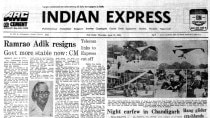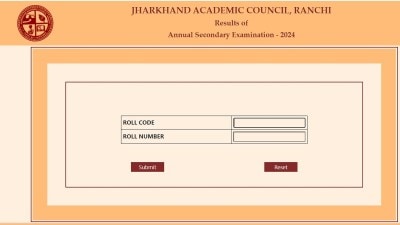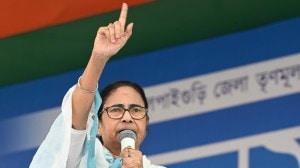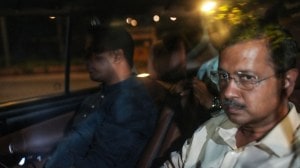- India
- International
The shot of Rajiv Gandhi getting hit — history in a frame
Nirupama Subramanian writes: Vidanagama, who passed away on June 6, at the age of 76, was a staff photographer at the Sri Lankan government-owned Lake House publications whose stable of newspapers include the Daily News. He and Amal Jayasinghe, then a Daily News reporter,
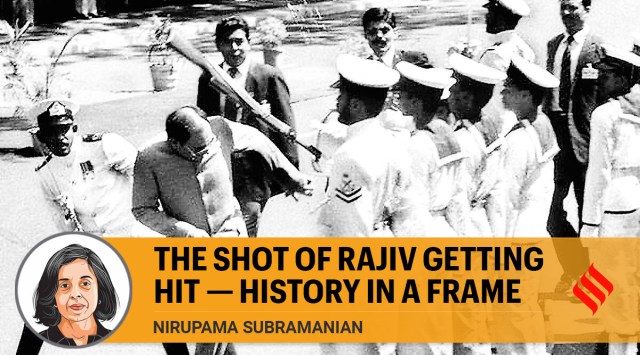 The photograph shot by Sena Vidanagama of Rajiv Gandhi being assaulted in Colombo.
The photograph shot by Sena Vidanagama of Rajiv Gandhi being assaulted in Colombo. Few photographs can claim to have captured the exact moment. Even Henri Cartier-Bresson, the master, said finally it was all down to luck. And luck was with Sena Vidanagama on July 30, 1987.
Vidanagama, who passed away on June 6, at the age of 76, was a staff photographer at the Sri Lankan government-owned Lake House publications whose stable of newspapers include the Daily News. He and Amal Jayasinghe, then a Daily News reporter, were assigned to cover Rajiv Gandhi’s departure from Sri Lanka a day after the signing of the India-Sri Lanka Accord. Vidanagama’s black-and-white photograph of what happened that day, taken with an Asahi Pentax, would earn it — and Vidanagama — a place in the pantheon of journalism’s greatest moments.
 Sena Vidanagama
Sena Vidanagama
The portents around the Accord were hardly propitious. The news that Indian soldiers were to be stationed in the Tamil-dominated Northeast had already created an uproar in Sri Lanka’s Sinhala-dominated south. Nationalist anger against the Indian intervention — the training of Sri Lankan militants by India, an IAF food drop over Jaffna in June 1987 at a time Sri Lankan forces had laid siege to the northern peninsula and believed they were on the verge of victory, the culmination in the landing of Indian troops – would lead to a full-scale insurgency over the next three years.
On July 28, a day before the Accord was signed, 19 people were killed in Colombo as police opened fire at protestors. In Delhi, there was uncertainty about Prime Minister Rajiv Gandhi’s two-day visit to sign the agreement. But it was decided that the agreement must be signed as scheduled.
On July 29, Colombo was under curfew. A contingent of 10,000 Buddhist monks gathered to march to the airport to protest when Gandhi arrived. As they broke the security cordon, the police fired on them, killing five. Gandhi was accompanied by wife Sonia. They arrived with their own bullet-proof car and a large security contingent, as well as a pack of Delhi journalists, and drove straight to a ceremonial welcome at the Galle Face Green. Prime Minister Ranasinghe Premadasa was conspicuous by his absence. The agreement was signed later in the day at the ornate presidential palace, further up the road.

On July 30, as Gandhi prepared to fly back to Delhi, he would leave behind an angry nation — in the north, the LTTE had rejected the agreement.
At the Daily News, Jayasinghe and Vidanagama were assigned to cover the departure ceremony. “It was not a high-priority assignment, just a ceremonial event,” Jayasinghe, who later headed the Colombo bureau of the AFP, recalled. The duo were hardly expecting an attempted assassination of the Indian prime minister as he inspected a guard of honour on the road outside the presidential palace.
As a band played, Gandhi inspected the navy line up. A junior sailor stepped out just after Gandhi had passed him and brought his rifle butt down on the prime minister. Gandhi ducked just in time, looking back as he did, and took the hit on his shoulder. Within minutes, he was back beaming on the ceremonial dais with Sonia, President J R Jayewardene and the First Lady. The 22-year-old sailor, Wijemuni Vijitha Rohana de Silva, was caught and jailed and eventually sentenced to seven years in prison. He was released after a couple of years following a pardon by Premadasa who had become President by then.
Vidanagama was the only photographer on the scene to capture the exact instant of the attack in a still shot, remarkably full of movement – Gandhi’s ducking action and his backward glance, Wijemuni’s rifle butt swinging down on his shoulder, the navy guardsman by Gandhi’s side leaning to one side, shock on his face.
🚨 Limited Time Offer | Express Premium with ad-lite for just Rs 2/ day 👉🏽 Click here to subscribe 🚨
Remember, that this was years before the first digital camera made its appearance. Back then, cameras had to be loaded with film, and after every shot, a lever cranked to move the film to the next frame. A photographer could not be sure of the image he had captured before the film was developed and the negatives were hung up to dry.
Thulasi Muttulingam, an ex-Daily News staffer, has recounted in a blog post an interview of Sena in which he details how he took the shot from a six-foot-high media dais on which all the vantage points had been taken up by international photographers and the Indian and Sri Lankan official TV cameras. But everyone thought the assignment was done after clicking photos of Gandhi’s first few steps at the guard of honour, and had let their cameras down.
“I too had finished clicking Rajiv Gandhi inspecting the Guard of Honour but kept watching him as he moved down the line of sailors. I acted reflexively when I saw one of the men move from the orderly line of sailors that Gandhi was inspecting. I really had no time to understand or process what was happening. I simply raised my camera and clicked. At the back of my mind, I had a vague notion that the sailor was fainting but after all, even that was news. I had no idea at that point that I was clicking an assault. It all happened very fast… If I had had a camera with today’s technology, I could have taken all these shots but I had to crank my Asahi Pentax before each new shot, to focus properly and thus lost out on quite a few [moments]. In those days you couldn’t click pictures one after the other like you can now.”
With the reel pushed into his socks, Vidanagama ran with Amal all the way to Lake House. But it was hardly certain that the photograph would see the light of day. There was a standoff between the editor and the Lake House boss, who was also an adviser to the President.
The President had already told the media that it was an accident — Wijemuni, the attacking sailor, had fallen from a heatstroke. This was the story the Sri Lankan government wanted to retain. Vidanagama’s photographs showed otherwise.
The Indian side too wanted to play down the incident, writes ANI chairman Prem Prakash in his book, Reporting India. He ran a pre-ANI agency that supplied footage to foreign wires, and had filmed the entire incident. No other Indian journalist was present at the guard of honour. On the plane back to Delhi, as he was telling the rest of the hack pack about the incident, the Prime Minister’s media adviser, H Y Sharada Prasad, told him not to spread “misinformation” and that “there was no such incident”.
Amid protests from the journalists, Gandhi watched the tape on the flight. Prakash told him the entire international press corps was present and was also certain to have captured the incident. Both sides realised quickly it was pointless to hide the facts.
Sena’s photo was on the front page of not just the Daily News but in papers across the world as the French newswire service AFP bought the image from Lake House. In the Daily News, it was captioned Sri Lanka’s “Hour of Shame”. The newspaper reported that the Indian Prime Minister had transmitted a special message thanking J R Jayewardene for his warmth and graciousness. The Sri Lankan president apologised to Gandhi for the assault. He later said on Sri Lankan state TV that he had apologised to Gandhi, his wife and their children, as well to the government and people of India for the incident.
As for Wijemuni, in an interview with the Sri Lankan newspaper Daily Mirror some years ago, he said: “I was thinking how India was helping the LTTE with money, arms and military training. The idea to attack with the rifle struck my mind when Rajiv Gandhi was about two or three feet away from me”. He tried his hand at politics, turned astrologer and was arrested once again in 2018 for a prediction that there would be an attempt on the life of then President Maithripala Sirisena.
Vidanagama’s photograph became the definitive image of the attack. I treasure a copy given to me by the photographer as a piece of journalistic excellence.
EXPRESS OPINION
More Explained
Apr 19: Latest News
- 01
- 02
- 03
- 04
- 05











